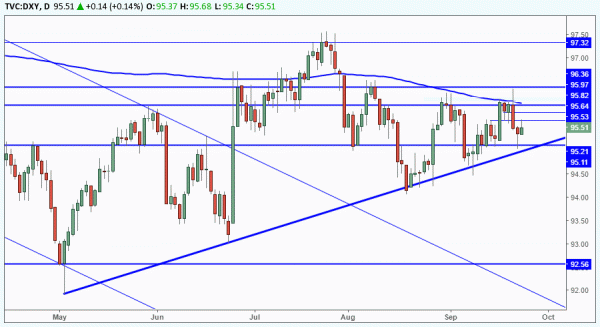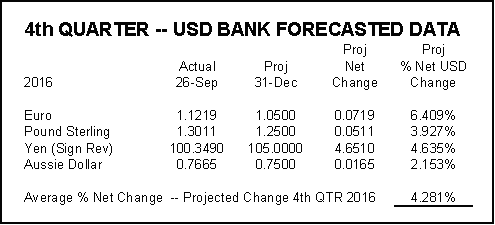The long-anticipated Fed meeting in September has now come and gone, and not much has changed, especially with respect to the positioning of the U.S. dollar versus its major pairing partners. The official statement from the Federal Open Market Committee had the familiar ring of caution: “The committee judges that the case for an increase in the federal funds rate has strengthened but decided, for the time being, to wait for further evidence of continued progress toward its objectives.” Stocks initially rallied at the thought of more accommodation, but soon gave up their temporary gains. The USD Index weakened a bit on the news, but it, too, regained lost ground, sticking to its tight range.
For this time around, however, the committee seemed divided in its judgment of the current situation. Janet Yellen has been praised in the past for her ability to corral disparate opinions from her banking buddies and to appear to be a united front when it came to Fed policy pronouncements. The so-called “hawkish” block of Esther George, Loretta Mester and Eric Rosengren actually dissented from the statement, choosing to vote “No” and signaling that a December rate hike may be a sure thing. As much as the Fed likes to claim that politics do not influence their decisions, waiting another three months would delay action until after the most contentious presidential race in history.
Analysts were quick to pick up the dropped baton. Kathy Jones, chief fixed income strategist at Charles Schwab (NYSE:SCHW), waxed eloquently that, “The solid coalition is still going to be there with Yellen, (William) Dudley, (Stanley) Fischer and a handful of others. I think they're still all in agreement. I can only surmise there's a division between those who think that we are in this secular stagnation world — slow growth for a longer time — vs. those who think it's a cyclical issue that's taking a very long time to play out." The outcome of the meeting was not a surprise. The committee met expectations.
The committee wanted to make clear that they did observe favorable signs in the economy by adding these descriptive sentences to their narrative:
• “The labor market has continued to strengthen and growth of economic activity has picked up from the modest pace seen in the first half of this year.”
• “Although the unemployment rate is little changed in recent months, job gains have been solid, on average.”
• “Household spending has been growing strongly but business fixed income has remained soft.”
• Inflation targets will be hit “as the transitory effects of past declines in energy and import prices dissipate and the labor market strengthens further.”
In the past, the Fed had expressed concern over global economic issues, but their recent statement barely touched upon the impacts of Brexit or ongoing slowdowns in China. They did, however, soften their forecast of rate hikes in the future, more in line with what recent surveys have predicted. The committee now sees “two hikes in 2017 and three each in 2018 and 2019 that would bring the funds rate to about 2.625 percent, assuming that each increase would come in quarter-point increments.”
As for the U.S. economy, they downgraded GDP growth for 2016 to 1.8%, a tad lower than the previous 2% forecast. Inflation estimates also fell from 1.4% to 1.3%, well below the accepted target of 2%. At her press conference, Yellen remarked, “Our decision does not reflect a lack of confidence in the economy. The committee agrees that risks to the outlook have become roughly balanced.” She added that the need for more gradual changes in interest rates going forward was to prevent the economy from “overheating”, and she rebuked the criticism coming from conservatives by saying, “We do not discuss politics at our meetings, and we do not take politics into account in our decisions.”
Why did the Dollar choose to go nowhere fast?
The probability of a September rate hike, as inferred from the futures markets, had been declining from 34%, as the date of the 21st approached. Although many Fed members had spoken of a potential adjustment on their respective speaking tours, the vast majority of analysts and pundits had surmised that the Fed did not want to rock the economic boat before the November elections. Roiling the financial markets would play into the hands of conservatives and unduly influence the voting public, or so goes conventional wisdom on this topic, regardless of Yellen’s protestations.
As for the dollar, it has been stuck within a tight range for months, as this chart reveals:tvx

This daily chart goes back to May, the endpoint for the previous downward channel that prevailed for the first part of the year. The USD had just come off a tremendous uptrend since 2014 when it was apparent that the Fed’s monetary policy would be the first to diverge from the pack. The dollar’s historic rise from an index perspective witnessed a rise from 78.9 in May of 2014 to 100.7 a year later. It declined from there, waiting for action from the Fed, which came in December. Four adjustments were forecast for 2016, but, when it became obvious that the Fed would not follow through on its plan, the Dollar took a hit down to 92.0 before resuming a gradual rise to a 95.0 midpoint average.
The heavy dark blue line reflects the anticipation that was building that the Fed would actually make a September and a December quarter-point hike in its benchmark rate, but you could easily add a descending line August forward to represent the formation of a symmetrical triangle. This triangle suggests that a new December decision point would be the next positioning for a major move in pricing behavior. It remains to be seen if the index stays within its tight 95-ish corridor. The upcoming election will surely generate a level of volatility until market uncertainty recedes. In the meantime, growth and monetary divergence risks will rule the day.
For the time being, we sit and ponder at the 95 level. Technical indicators currently display a negative bias for the near term. As long as interest rates from other major jurisdictions hover in negative territory, the greenback will still offer the best overall yields on a comparative basis. When one fundamental offsets another technical bias, the market’s result is often to stand still. Another calm is developing before an eventual storm, but the source and timing of the storm clouds remain up for speculation.
What are major banking departments forecasting for the USD Index at yearend?
2016 was supposed to be a rather boring year, when it came to forecasting foreign exchanges rates. Major bank forex departments had reached consensus early that monetary policy divergence would drive rate changes to be determined by how and when a series of Fed interest rate adjustments would roll out. The Brexit referendum was not even on the radar at the time. Commodities were in a five year long downdraft, but most indications were that they would recover, albeit gradually. China was a concern, but Chinese officials had already developed a reputation for intervention when it was called for.
As the year rolled out, any Fed adjustments became suspect. Brexit happened. Europe and China dragged along, while Japan remained Japan, frozen in place for nearly two decades. As a result, forex departments have made many changes to their best guesstimates. Here is the latest table of changes from now until the end of the year:
The consensus now is that the USD will appreciate some 4.3% versus these major pairings, driving the index to something between 99 and 100 on that scale. At the start of the year, 110 was the upward estimate, but it was predicated on a more aggressive Fed. Central bankers have been cautious for good reasons, and remain so. Near zero and negative interest rate policies have allowed capital to seep into areas that cannot afford higher interest rates. Carry-trade volume is perilously close to the $12 trillion mark. If interest rates are raised too high too quickly, then a global unraveling of monstrous proportions could take place, creating the much feared liquidity crunch across the globe.
If there was to be higher volatility following the summer break, the bounce has been weak. We are once again sitting on a precipice, waiting for the Fed to take action, waiting to discover who the next President of the United States will be, and waiting for all economies to pick up the pace in the last quarter. Historically, October has not been a great month, if a calm month receives low ratings. One good volatility spike has occurred each October for the past few years, so we can wait for that event risk, too.
Are all currencies weak at this moment?
Major currencies may be reeling versus the USD, but there is one currency that has not – Gold. Since the Great Recession, we have witnessed the great debasement of paper money versus the oldest currency used by man. Since last December, the rally in Gold prices has drawn little in the way of press coverage, yet it rocketed from $1,046 an ounce to $1,380 in July, a nice 32% jump in appreciation. It has pulled back to the $1,340 level and held a tight range for the last three months.
Central bankers rarely talk about Gold, but, as one analyst puts it, “Central banks around the world hold gold as part of their foreign currency reserves. In the U.S. and Europe, the importance of the yellow metal emanates from the fact that over 70% of total foreign exchange reserves are in gold. Central banks and monetary authorities rarely discuss gold; it is almost a taboo topic. The reason for this is that governments cannot print more gold; they can only buy or sell the metal.”
Concluding Remarks
The Dollar Index is stuck in neutral again, biding its time in the mid-nineties, until conditions change. Bankers seem dead certain that the Fed will act in December, as it did a year ago, the reason for their appreciation scenarios going forward. There are, however, a number of moving parts in this drama, any of which could derail these rather conservative projections.
The Presidential election could render all of these forecasts both null and void. A softening in the U.S. economy, another fall in oil prices, or problems in Europe or China could also make the Fed reconsider, actions that would send the Dollar gasping for 92 and beyond. For now, the majority sees a 100 value by year end, but the herd is often wrong. Stay cautious!
Risk Statement: Trading Foreign Exchange on margin carries a high level of risk and may not be suitable for all investors. The possibility exists that you could lose more than your initial deposit. The high degree of leverage can work against you as well as for you.
by Tom Cleveland